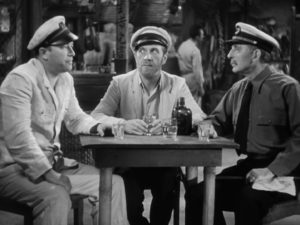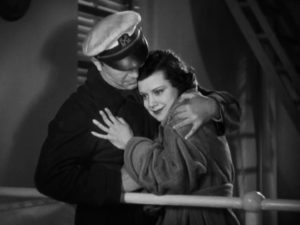General Information
Director: Ernest B. Schoedsack
Writer: Ruth Rose
Cast: Robert Armstrong, Helen Mack, Frank Reicher, John Marston, Victor Wong, and Ed Brady
Composer: Max Steiner
Release Date: 12/22/1933
MPAA Rating: Not Rated
Overview
Avoiding legal and financial ruin, Carl Denham leaves New York with comrades Capt. Englehorn and Charlie the Chinese Cook (Victor Wong). Having also picked up Norwegian skipper Nils Helstrom (John Marston) and Hilda (Helen Mack), a young woman whose father was killed by Helstrom, Denham and company embark on a return voyage to Skull Island. Shortly thereafter, the Venture crew members encounter a new surprise in the form of “Little” Kong—the benign, white-colored offspring of Kong.
picked up Norwegian skipper Nils Helstrom (John Marston) and Hilda (Helen Mack), a young woman whose father was killed by Helstrom, Denham and company embark on a return voyage to Skull Island. Shortly thereafter, the Venture crew members encounter a new surprise in the form of “Little” Kong—the benign, white-colored offspring of Kong.
A lighthearted sequel to King Kong, The Son of Kong offers plenty of good, clean fun for people of all ages. There are instances, however, when family-friendly antics hamper an otherwise terrifying concept (i.e. humans trapped on an island with dinosaurs and giant apes).
Pros
 As opposed to King Kong, The Son of Kong spends a great deal of time acquainting the audience with each main character. Particularly worth noting is the development of Denham, who, now stricken with remorse, exemplifies a much softer, more sympathetic manner than in the previous film. The addition of Helstrom’s character should also be praised, especially for providing a realistic, human antagonist to complement writer Ruth Rose’s fantasy-themed conflict—yet another area where The Son of Kong excels over the original King Kong.
As opposed to King Kong, The Son of Kong spends a great deal of time acquainting the audience with each main character. Particularly worth noting is the development of Denham, who, now stricken with remorse, exemplifies a much softer, more sympathetic manner than in the previous film. The addition of Helstrom’s character should also be praised, especially for providing a realistic, human antagonist to complement writer Ruth Rose’s fantasy-themed conflict—yet another area where The Son of Kong excels over the original King Kong.
Cons
Having stripped away the mystery from Skull Island, The Son of Kong fails to recapture the compelling sense of danger that defined its predecessor. The low threat level facing Denham, Hilda, Charlie, and Englehorn becomes most apparent during Little Kong’s battle with a giant bear, the details of which border on comedic at times—a stark contrast to the riveting monster action for which King Kong is known.
during Little Kong’s battle with a giant bear, the details of which border on comedic at times—a stark contrast to the riveting monster action for which King Kong is known.
Also problematic is the film’s climax, which suffers from an abrupt, hackneyed execution. Specifically, Skull Island is washed away too quickly for viewers to absorb the impact of Little Kong’s sacrifice, thereby undermining the emotional effect that the climactic scene attempts to convey.
Analysis
 The Son of Kong contains a worthwhile message on the value of redemption. Notably, Denham initially evades the consequences of his actions, choosing to flee the country instead of confronting those whom Kong had injured in the prior installment. By taking Little Kong under his wing, however, Denham compensates for any past crimes committed against nature—a heartwarming gesture for which he is rewarded at a later time.
The Son of Kong contains a worthwhile message on the value of redemption. Notably, Denham initially evades the consequences of his actions, choosing to flee the country instead of confronting those whom Kong had injured in the prior installment. By taking Little Kong under his wing, however, Denham compensates for any past crimes committed against nature—a heartwarming gesture for which he is rewarded at a later time.
Concluding Comments
The Son of Kong is a decent, if unremarkable, sequel to one of the most iconic movies ever made. Kong enthusiasts may therefore enjoy this effort, which poignantly combines human drama with monster mayhem.
Overall Quality: 6/10
If you enjoyed this post, please enter your email address in the subscription box to stay tuned for more updates.
